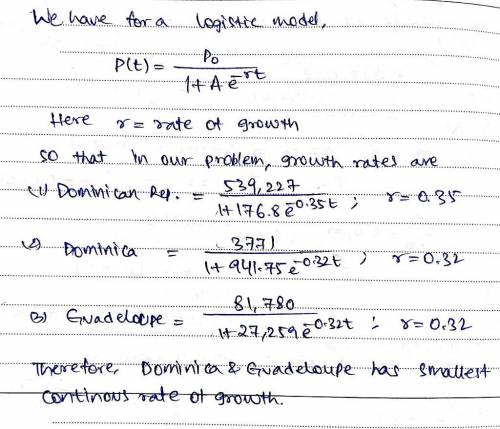
Mathematics, 25.04.2020 04:00 micahatwood03
The disease chikungunya arrived in the Americas in 2013 and spread rapidly in 2014. While seldom fatal, the disease causes debilitating joint pain and a high fever. In August 2014, a public challenge was issued to predict the number of cases in each of the affected countries. The winners, Joceline Lega and Heidi Brown, used a logistic model to make their predictions. Let N be the total number of cases of chikungunya in a country by week t, where t is measured since the first cases were recorded in that country. The progress of the disease in three Caribbean countries is represented by the logistic functions:
Dominican Republic= 539. 227/ 1+ 176.8 e^-0.35t
Dominica = 3771/ 1+941.75 e^-0.32t
Guadeloupe= 81,780/ 1+ 27,259 e^-0.32t
When the number of was still small, in which of these three countries did the number of cases grow at the smallest continuous rate?
a. Dominica and Guadeloupe
b. Guadeloupe and the Dominican Republic
c. The Dominican Republic and Dominica
What rate was that? Enter your answer in decimal form, not as a percent.

Answers: 3


Other questions on the subject: Mathematics

Mathematics, 21.06.2019 13:30, marlesly87
Estimate the product. round the first factor to the nearest whole number, round the second factor to the nearest ten, and then multiply. 3 8/9 × 96
Answers: 3

Mathematics, 21.06.2019 18:00, peytondavis2424
Plz determine whether the polynomial is a difference of squares and if it is, factor it. y2 – 196 is a difference of squares: (y + 14)2 is a difference of squares: (y – 14)2 is a difference of squares: (y + 14)(y – 14) is not a difference of squares
Answers: 1


Mathematics, 22.06.2019 02:00, embersongracie
Asix-sided die of unknown bias is rolled 20 times, and the number 3 comes up 6 times. in the next three rounds (the die is rolled 20 times in each round), the number 3 comes up 6 times, 5 times, and 7 times. the experimental probability of rolling a 3 is 10 %, which is approximately % more than its theoretical probability. (round off your answers to the nearest integer.)
Answers: 1
You know the right answer?
The disease chikungunya arrived in the Americas in 2013 and spread rapidly in 2014. While seldom fat...
Questions in other subjects:


English, 12.12.2019 01:31





Mathematics, 12.12.2019 01:31

Mathematics, 12.12.2019 01:31


Mathematics, 12.12.2019 01:31




